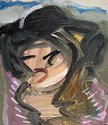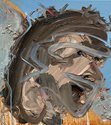John Hurrell – 28 March, 2021
Happily some of these works are in series, for to see such variations on a theme is an unusual treat. 'Goodnight Irene (Irene blowing her nose with flowers)' is in three versions, and the similar 'Irene dancing in a wild garden with flowers' is in two. There are also three other (single) Irene portraits: wearing a blue hair-tie, playing with a cat, and wearing her mother's wide brimmed hat.
In this latest show of agitated viscous oil paintings by Toby Raine, the artist (for a subject) focuses on his stepdaughter Irene. Whilst typically distorted and streaky in their angular fractured imagery—and blending of adjacent coloured planes—the eleven squiggly works are also surprisingly decorative and celebratory, showing the young adolescent playing with the family cat and smelling flowers.
They have an unusual lyricism and sweetness; accentuated perhaps by the conspicuous flowers. In terms of the title, maybe the artist himself (as well as Irene) is ‘the last innocent thing left’?
Happily some of these works are in series, for to see such variations on a theme is an unusual treat. Goodnight Irene (Irene blowing her nose with flowers) is in three versions, and the similar Irene dancing in a wild garden with flowers is in two. There are also three other (single) Irene portraits: wearing a blue hair-tie, playing with a cat, and wearing her mother’s wide brimmed hat.
The artist’s self portrait (smoking) and the image of Jesus Christ (set against a deep blue sky) are the only non-Irene portraits to be seen.
Plus there is an adult nude. In this one naked female image painted from behind, Raine moves away from an Auerbach influence (less ‘finger painting’, less thick in substance) towards de Kooning (thinner application and wider brushmark swathes). The image is less frenetic than most of the portraits—not angular—and grander in its wide vertical smeary sweeps.
I don’t think Raine is capable of being sugary, even when using everyday domestic subject matter featuring the people he loves. These swirly works are obviously emotional, but they are also tough—and initially hard to decipher. They are confusingly abstract, realigned and greasy, but still fascinate as translations of human tenderness. You are forced to search for clues pertaining to facial parts, clothing, animals and botany. Doing this analysis is part of their pleasure.
John Hurrell
![Toby Raine, Goodnight Irene (Irene blowing her nose with flowers) [Version ii], 2021, oil on linen, 700 x 600 mm](/media/thumbs/uploads/2021_03/goodnight-irene-irene-blowing-her-nose-with-flowers-version-ii-2021_jpg_380x500_q85.jpg)
![Toby Raine, Goodnight Irene (Irene blowing her nose with flowers) [Version iii], 2021, oil on linen, 700 x 600 mm](/media/thumbs/uploads/2021_03/goodnight-irene-irene-blowing-her-nose-with-flowers-version-iii-2021_jpg_380x125_q85.jpg)
![Toby Raine, Goodnight Irene (Irene blowing her nose with flowers) [Version v], 2021, oil on linen, 700 x 600 mm](/media/thumbs/uploads/2021_03/goodnight-irene-irene-blowing-her-nose-with-flowers-version-v-2021_jpg_380x125_q85.jpg)
![Toby Raine, Irene dancing in a wild garden with flowers [Version ii], 2021, oil on linen, 700 x 600 mm](/media/thumbs/uploads/2021_03/irene-dancing-in-a-wild-garden-with-flowers-version-ii-2021_jpg_380x125_q85.jpg)
![Toby Raine, Irene dancing in a wild garden with flowers [Version iii], 2021, oil on linen, 700 x 600 mm](/media/thumbs/uploads/2021_03/irene-dancing-in-a-wild-garden-with-flowers-version-iii-2021_jpg_380x125_q85.jpg)






 Advertising in this column
Advertising in this column Two Rooms presents a program of residencies and projects
Two Rooms presents a program of residencies and projects



This Discussion has 0 comments.
Comment
Participate
Register to Participate.
Sign in
Sign in to an existing account.